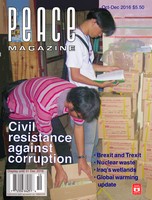
Peace Magazine Oct-Dec 2016, page 11. Some rights reserved.
Search for other articles by Rene Wadlow here
On 22 August 2016, Ahmad Al-Faqi Al-Mahdi pleaded guilty to organizing and helping to carry out the destruction of nine tombs of Sufi saints in Timbuktu, northern Mali. This is the first time that a defendant has pleaded guilty at the International Criminal Court (ICC). It is also the first time that the destruction of UNESCO-designated cultural heritage of humanity sites has been a central part of the prosecutor’s case against the accused.
The evidence against Al-Faqi Al-Mahdi was overwhelming, as originally he was proud of his iconoclastic reputation and spoke openly in public meetings and in his talks to the “oral police,” of which he was the intellectual guide. From March 2012 until January 2013, when French troops were sent to Mali under a Security Council mandate, much of northern Mali was under the control of Ansar Dine which tried to impose its understanding of Islamic law in all its most narrow and repressive forms. Music, smoking, and alcohol were banned, and Sufi tombs were destroyed. Much of Islamic practice in northern Mali is Sufi-influenced, a devotional current with an emphasis on personal practice rather than communal worship. Sufi leaders are considered “saints”— the Roman Catholic terminology being the closest equivalent. At the death of certain Sufi saints, a mausoleum is built. In the case of north Mali, the mausoleum is of dried mud and brick: rather easily destroyed if that is one’s aim.
For most of Malian history, Sufi practices co-existed with little tension with other Islamic practices. However, the iconoclastic and anti-Sufi positions of Saudi Arabia have been spread both by Saudi preachers going to preach in other countries and by people going to study Islam in Saudi Arabia. Al-Faqi Al-Mahdi was trained in both a non-Sufi Koranic school in north Mali, not far from Timbuktu, and in Saudi Arabia. He was also trained in a Malian government school for teachers, and had been the chief teacher of a primary school in north Mali.
There has been growing international concern about the wanton destruction of cultural heritage. On 27 February 2015, the UN Security Council condemned “the deliberate destruction of irreplaceable religious and cultural artifacts housed in the Mosul Museum and burning of thousands of books and rare manuscripts from the Mosul Library.”
A few days earlier, thousands of books from Mosul’s University Library had also been burned. The Mosul Museum had a large number of statues from the pre-Islamic Mesopotamian civilizations as well as statues from the Greek Hellenistic period. The spokesman for the Islamic State faction which carried out the destruction maintained that the statues represented gods which had been worshipped, while only the true god should receive worship. This approach to pre-Islamic faiths and their material culture is the same as had led to the destruction of the large Buddha statues in Bamiyan, Afghanistan—monuments that attested to the rich culture along the Silk Road.
However, the destruction of the Sufi tombs in Timbuktu highlights new and dangerous currents of division within the wider Islamic community—anti-Sufi actions which need to be watched and countered.
There have been earlier efforts to preserve cultural heritage in times of armed conflict, in particular the Pan-American Roerich Pact of 1935 and the Hague Convention of 1954, but the ICC trial of Ahmad Al-Faqi Al-Mahdi is the first case of an international court dealing with the deliberate damage of UNESCO-designated cultural sites.
Although the Sufi tombs have been rebuilt, largely by the efforts of the local population, the concept of the criminalization of deliberate destruction of cultural heritage is slowly becoming part of world law: a trend to be encouraged. _René Wadlow is the President of the Association of World Citizens.

Peace Magazine Oct-Dec 2016, page 11. Some rights reserved.
Search for other articles by Rene Wadlow here